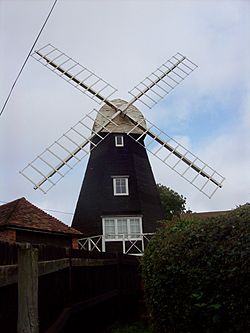Charing Windmill facts for kids
Quick facts for kids Charing Windmill |
|
|---|---|

The converted mill.
|
|
| Origin | |
| Mill name | Field Mill |
| Grid reference | TQ 957 503 |
| Coordinates | 51°13′1″N 0°48′8″E / 51.21694°N 0.80222°E |
| Year built | Early nineteenth century |
| Information | |
| Purpose | Corn milling |
| Type | Smock mill |
| Storeys | Three-storey smock |
| Base storeys | One storey |
| Smock sides | Eight-sided |
| No. of sails | Four |
| Type of sails | Two Common sails and two Spring sails |
| Windshaft | Cast iron |
| Winding | Fantail |
| Fantail blades | Six |
| No. of pairs of millstones | Three pairs |
| Other information | Was painted white when a working mill, tarred black since conversion to a house. |
The Charing Windmill is a special building in Kent, southeast England. It is a type of windmill called a smock mill. Today, it is no longer used for grinding grain. Instead, it has been changed into a house.
This windmill is sometimes called Field Mill. However, there was also a watermill in Charing with the same name. The Charing Windmill is a Grade II listed building. This means it is an important historical building that needs to be protected.
Contents
The Windmill's Story
When Was Charing Windmill Built?
The Charing Windmill was built a long time ago. It was built in the early 1800s. We know this because it appeared on old maps. It was on the 1819-43 Ordnance Survey map. It was also on Greenwood's 1821 map of Kent.
How Long Did the Windmill Work?
The windmill worked for many years. It was used to grind corn until 1891. After that, the milling business moved. It went to the Field Watermill nearby.
Just one year before it stopped working, in 1890, the windmill got new parts. A company called Holman's from Canterbury put up two new sails. Sadly, these sails did not last forever. In 1917, a strong storm damaged them. So, they had to be removed.
What Does the Windmill Look Like?
Charing Windmill's Structure
The Charing Windmill is a smock mill. This type of windmill looks like a person wearing a smock, which is a loose outer garment. It has three main levels, or 'storeys'. These levels sit on top of a single-storey base. The top part of the mill, called the 'cap', is shaped in a style common in Kent.
How Did the Windmill Work?
The windmill used to have four large sails. Two were called Common sails, and two were Spring sails. These sails caught the wind. A special part called a fantail helped turn the cap. This made sure the sails always faced the wind. The fantail had six blades to help it turn.
Inside the mill, a strong metal shaft called a windshaft connected to the sails. This shaft was made of cast iron. It turned a large wooden wheel called a Brake Wheel. This wheel then turned another wooden wheel, the wallower. The wallower was on a tall wooden shaft. This shaft went down through the mill.
At the bottom, a big wooden wheel called the Great Spur Wheel was connected. This wheel used to turn three pairs of millstones. The millstones were used to grind corn into flour. Today, these millstones are no longer inside the mill.
How the Windmill Changed Over Time
When the Charing Windmill was first built, it was painted white. This was its original color. But in 1969, the main body of the mill was treated with a dark wood preservative. This changed its color. Now, it is a dark, tarred black color.
Images for kids


